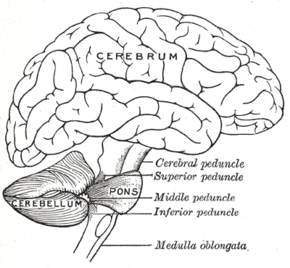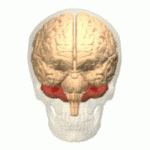Philosophy:Cerebellar theory of dyslexia
| Cerebellum | |
|---|---|
 Drawing of the human brain, showing cerebellum and pons | |
 Location of the human cerebellum (in red) | |
| Details | |
| Part of | Hindbrain |
| Identifiers | |
| Latin | Cerebellum |
| Anatomical terms of neuroanatomy | |
The cerebellar theory of dyslexia asserts that a mildly dysfunctional cerebellum can cause dyslexia. This theory was initially proposed by Harold Levinson and Jan Frank in 1973 and further developed by Levinson and other researchers. Angela Fawcett and Rod Nicolson later proposed that the cerebellum contributes to motor control during the articulation of speech, and that articulation problems can contribute to the phonological processing deficits that can cause dyslexia. They also reasoned that the cerebellum contributes to the automatisation of learned behaviors, which may include learning the grapheme-phoneme relationships when reading text.[1]
The cerebellar theory argues that the cause of dyslexia is an abnormality in the Cerebellum (a region in the back of the brain). According to cerebellar theory, abnormalities in the cerebellum cause disruption in normal development, which causes issues with motor control, balance, working memory, attention, automatization, and ultimately, reading. The cerebellar theory of dyslexia is one of the five major current theories in dyslexia research (others include the phonological processing theory, the rapid auditory processing theory, the visual theory, and the magnocellular theory).[2][page needed]
References
- ↑ "The cerebellum and dyslexia". Cortex 47 (1): 101–16. October 2009. doi:10.1016/j.cortex.2009.10.005. PMID 20060110.
- ↑ Mody; Sillman (2008). Brain, Behavior, and Learning in Language and Reading Disorders. London : The Guilford Press. ISBN 978-1593858315.

